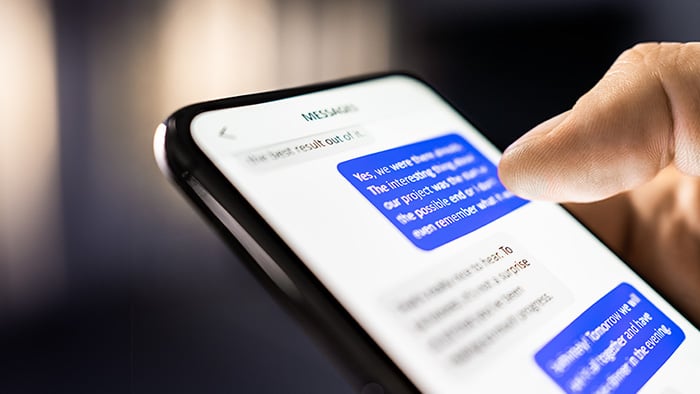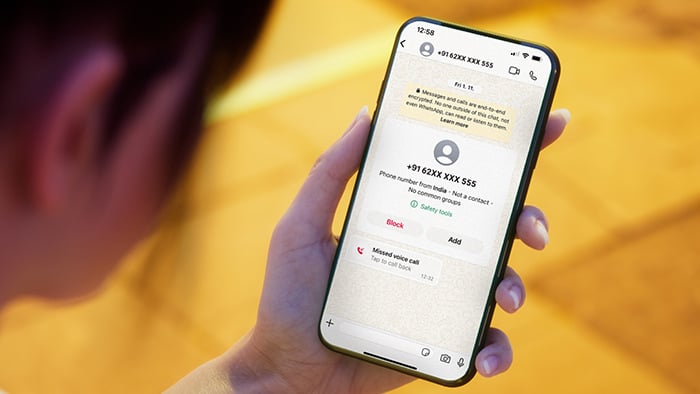What is a fake text message?
A fake text message is a text that appears to be from a legitimate source but is sent by a scammer, spammer, or another malicious party. The purpose of fake texts is typically to obtain your personal information, deceive you, or otherwise cause harm. Learning how to identify a fake text message can help you avoid falling victim to text message scams.
How to identify a fake text message
Fake texts can be sophisticated and creative, which can make it difficult to spot them. Scammers may use everything from phone number spoofing to fake news headlines to get you to trust a fake message, give out your personal information, click a link, or open an attachment. One of the most common types of fake text messages involves scammers impersonating an organization like the USPS.

Identifying a fake text message on an iPhone or Android is crucial to protecting yourself from scams, identity theft, or accidentally installing harmful software like adware. To determine if a text message is legitimate or not, pay attention to suspicious sender information, message content, and links or attachments included in the message.
Suspicious sender information
The first thing to look at when receiving a text message is the sender's phone number. Here are specific things to watch out for when identifying fake messages:
-
Number irregularities
Scammers may use numbers with extra or repeated digits (for example, 1234567890 or 9999999999). But, a fake blocked text message won’t let you see the number, since it comes from a blocked number. In this case, use the next two sections.
-
Alphanumeric senders
If you receive a spoofed message from an alphanumeric sender (e.g., "AMAZON"), be cautious. While businesses might use alphanumeric sender IDs legitimately, scammers also use them to make their messages appear valid by using a trusted name.
-
Foreign country codes
Be wary of text messages from foreign country codes, especially if you are not expecting communication from that location.
Suspicious message content
The next step is to closely examine the content of the message. Here are some key signs that you may be dealing with a fake text:
-
Urgent tone
Fake messages frequently try to create a sense of urgency, pressuring you to act immediately (e.g., "Your account has been compromised! Click here to secure it now!").
-
Bad spelling, grammar, or formatting
Scammers sometimes use poor language in a fake text conversation, either out of carelessness or to evade your carrier’s spam filter. They may also use mismatched fonts and inconsistent text sizing.
-
Request for personal information
Real companies and institutions will never ask for sensitive personal information via text message. If you receive a message requesting such information, be very cautious.

Suspicious links or attachments
Watch out for text messages that contain links or attachments, especially if they come from unknown senders. Fake subscription texts or fake automated text messages often use embedded links to trick recipients into divulging sensitive information or downloading malware.
If you receive a suspicious link, check the URL carefully for any discrepancies or misspellings. You can also preview the link (without tapping) to check the actual destination. But, the safest practice is to never open links or download attachments from unverified sources.

Types of fake text messages
Some common fake spam text examples include:
Smishing texts
A combination of "SMS" and "phishing,” smishing uses fake texts to target victims with phishing scams. Smishing texts often impersonate a trusted entity, like a bank, in an attempt to trick you into visiting a pharming website and revealing sensitive information such as passwords or banking details. Common formats include fake confirmation texts and fake subscription texts.

Spear phishing is a type of phishing that involves a highly personalized cyberattack aimed at manipulating specific targets into divulging sensitive information or installing malicious software.
Romance scam texts
Some of the most deceitful of all fake text messages are romance scams. From catfishing to sugar daddy scams, these can lead to victims feeling hurt and humiliated. They can also be successful financial scams, causing victims to lose significant amounts of money.
Catfishing involves a scammer creating a fake online persona to manipulate their target once they gain their trust. Once they’ve built rapport, they may fabricate a crisis, texting the victim to send money to help them — for instance, they could ask to borrow $500 to cover emergency vet bills for their cat.

Scareware texts
Scareware text messages use fear to manipulate you into taking action before you have time to think further. For example, you may receive a text claiming that your device has been infected with a virus and prompting you to download a fake antivirus app to "fix" the problem, which installs malware onto your phone.
Under the scareware banner, scammers may also ask you to tap a dangerous link or visit an infected website. These actions could also lead you to inadvertently install malware like spyware or ransomware onto your device.
What to do if you receive a fake text
If you believe you’ve received a fake text message, follow these steps to protect yourself:
-
Do not reply. Responding to a fake text message, even just writing “STOP,” may confirm to the sender that your phone number is active, potentially leading to more messages.
-
Block the sender. Most smartphones allow you to block specific numbers or senders, preventing them from contacting you again.
-
Report the message. If you receive a fake text message that appears to be part of a bigger scam or is particularly harmful, report it to your mobile carrier or the appropriate authorities, such as the Federal Trade Commission in the United States.
-
Use security software. Ensure that your smartphone has updated security software installed to shield against malware and other potential threats.
Learn how to stop spam emails too, which can be part of a scam, like an Amazon phishing email. And protect all of your online accounts with two-factor authentication (2FA) whenever it’s available.

Protect yourself from fake texts
Awareness and vigilance are key to combating the ever-evolving tactics of scammers, but one of the strongest defenses against fake text messages is robust security software. Avast One is a complete solution for your digital security and privacy needs. Avast One is your own personal digital guardian, protecting you with award-winning antivirus software and a variety of other features like network security and a built-in VPN.




















